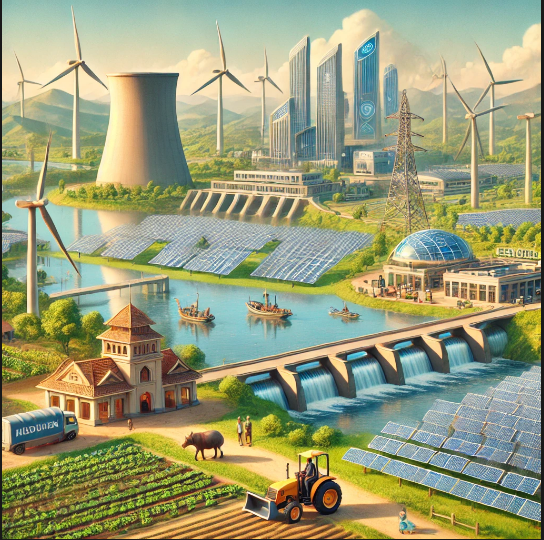Introduction
India, one of the fastest-growing economies in the world, faces an increasing demand for energy. The country’s energy sector has traditionally been dominated by fossil fuels, but the shift towards renewable energy has gained momentum in recent years. With abundant natural resources such as sunlight, wind, and hydropower, India has significant potential to transition to sustainable energy. This article explores the challenges and opportunities in India’s renewable energy sector.
Current Status of Renewable Energy in India
India has made remarkable progress in the renewable energy sector over the past decade. As of 2023, the country ranks among the top five global markets for renewable energy. The government has set an ambitious target of achieving 500 GW of non-fossil fuel capacity by 2030, aligning with international commitments to combat climate change. The key sources of renewable energy in India include:
1. Solar Energy
With an average of 300 sunny days per year, India has immense potential for solar energy. The country has developed large-scale solar parks, rooftop solar installations, and decentralized solar energy projects. The National Solar Mission has played a crucial role in driving solar energy adoption.
2. Wind Energy
India has the fourth-largest installed wind power capacity in the world. The states of Tamil Nadu, Gujarat, Maharashtra, and Rajasthan lead in wind energy generation. Offshore wind projects are also being explored to further enhance the sector.
3. Hydropower
Hydropower contributes significantly to India’s renewable energy mix, with both large and small hydro projects. However, environmental concerns and displacement issues have led to resistance in certain regions.
4. Biomass Energy
India has abundant agricultural and forestry waste, which can be converted into biomass energy. This source of energy plays a vital role in rural electrification and reducing reliance on traditional fuels.
5. Green Hydrogen
The National Green Hydrogen Mission aims to position India as a global hub for green hydrogen production, reducing dependence on fossil fuels and supporting industrial decarbonization.
Challenges in India’s Renewable Energy Sector
Despite impressive growth, the renewable energy sector in India faces several challenges that must be addressed to ensure sustainable progress.
1. Intermittency and Grid Stability
Renewable energy sources like solar and wind are intermittent in nature, posing challenges for grid stability. Energy storage solutions and grid modernization are essential to address this issue.
2. Land Acquisition and Environmental Concerns
Large-scale renewable energy projects require vast tracts of land, leading to conflicts over land acquisition and environmental degradation. Sustainable site selection and improved land policies are necessary.
3. High Initial Investment Costs
While renewable energy is cost-competitive in the long run, the initial capital investment remains high. Access to financing and incentives can help overcome this barrier.
4. Transmission Infrastructure
The existing transmission infrastructure needs significant upgrades to accommodate renewable energy generation and ensure efficient power distribution across states.
5. Policy and Regulatory Uncertainty
Frequent changes in policies, tariffs, and incentives create uncertainty for investors and developers. A stable and transparent policy framework is required to boost confidence in the sector.
6. Dependence on Imports
India still relies on imports for critical components such as solar panels, wind turbines, and battery storage systems. Enhancing domestic manufacturing through initiatives like the Production-Linked Incentive (PLI) scheme is crucial.
7. Storage and Battery Technologies
Energy storage solutions, such as advanced battery technologies, are essential to mitigate the intermittent nature of renewables. Research and development in this field need more investment.
8. Public Awareness and Acceptance
Raising awareness about the benefits of renewable energy and encouraging public participation is essential for large-scale adoption. Addressing misconceptions and promoting decentralized renewable solutions can enhance acceptance.
Opportunities for Renewable Energy Growth in India
While challenges exist, India’s renewable energy sector offers numerous opportunities that can accelerate its transition to a sustainable future.
1. Ambitious Renewable Energy Targets
The government’s target of achieving 500 GW of non-fossil fuel capacity by 2030 presents a massive opportunity for investment and innovation in the sector.
2. Job Creation and Economic Growth
The renewable energy industry has the potential to create millions of jobs, from manufacturing and installation to maintenance and research. This can contribute to economic development and rural empowerment.
3. Decentralized and Off-Grid Solutions
Decentralized renewable energy solutions, such as rooftop solar and microgrids, can provide electricity to remote and underserved regions, improving energy access.
4. Technological Advancements
Advancements in solar PV efficiency, wind turbine technology, and energy storage solutions are making renewable energy more viable and competitive with traditional sources.
5. Green Hydrogen Potential
Green hydrogen presents an opportunity to decarbonize industries like steel, cement, and transportation. India’s investment in this sector can position the country as a global leader.
6. Foreign Investment and Global Collaboration
India has attracted significant foreign direct investment (FDI) in renewable energy. International partnerships and collaborations can drive further growth and technology transfer.
7. Digitalization and Smart Grid Integration
The integration of digital technologies, such as AI, IoT, and blockchain, can enhance grid management, predictive maintenance, and energy efficiency. Smart grids can optimize renewable energy integration.
8. Carbon Credits and Emission Reduction
With global carbon markets expanding, India can leverage carbon credits and emissions trading to attract investments and incentivize clean energy adoption.
9. Rural Development and Energy Access
Expanding renewable energy infrastructure in rural areas can improve agricultural productivity, provide reliable electricity, and enhance overall socio-economic development.
Policy Support and Government Initiatives
The Indian government has introduced several policies and initiatives to promote renewable energy development. Some of the key programs include:
- National Solar Mission: Aims to increase solar power capacity through large-scale projects and rooftop installations.
- Wind Energy Mission: Focuses on expanding onshore and offshore wind energy generation.
- Production-Linked Incentive (PLI) Scheme: Encourages domestic manufacturing of solar panels and battery storage systems.
- KUSUM Scheme: Supports solar-powered irrigation and energy solutions for farmers.
- Renewable Energy Certificates (RECs): Facilitate trade in green energy and support renewable power producers.
Future Outlook
India’s renewable energy future looks promising, with a strong policy framework, technological advancements, and increasing investments. To achieve long-term sustainability, the country must focus on:
- Strengthening grid infrastructure and energy storage solutions.
- Enhancing domestic manufacturing to reduce import dependence.
- Promoting research and development in emerging renewable technologies.
- Encouraging private sector participation and public awareness.
Conclusion
The renewable energy revolution in India presents both challenges and immense opportunities. With the right policies, investments, and technological innovations, India can achieve its ambitious energy targets and lead the world in sustainable development. The transition to renewable energy will not only enhance energy security but also drive economic growth, job creation, and environmental sustainability. India’s commitment to a cleaner and greener future will shape its energy landscape for generations to come.




